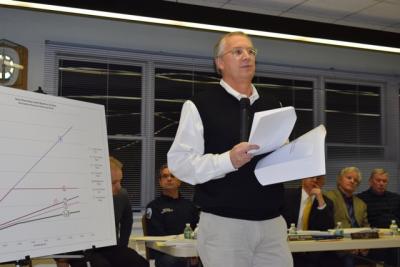Sag Harbor Zoning Changes Are on the Horizon

Sag Harbor Village police stood by just in case, and one person angrily addressing the village board over proposed residential zoning code changes came close to being hauled away from the podium, but feedback was largely positive at a meeting last week on proposals that include tying the gross floor area of residential structures to lot sizes.
In the face of a growing trend toward bigger houses on smaller lots, the village established a temporary moratorium in July on construction of most new houses and major improvements to existing ones; since then the board has been working on a range of code revisions. On Jan. 27, it detailed those proposals and heard questions and concerns from the public during a jam-packed meeting at the Sag Harbor Firehouse.
Rich Warren of Inter-Science Research Associates, the consultant who analyzed all 1,607 residential lots in Sag Harbor for the village, explained his findings at the meeting and discussed how they led to changes under consideration, the most controversial of which were new setbacks for swimming pools and the floor-area limit.
Sag Harbor is the only village on the South Fork that does not have limits on gross floor area. Using Mr. Warren’s analysis, the board came up with a ratio that allows for slightly bigger houses than are allowed in most neighboring villages and towns because, village officials said, Sag Harbor has unusually small lots by comparison. The proposed limits would allow 8 square feet of gross floor area for every 100 feet of lot area.
Under current zoning, a lot of 5,000 square feet or less could see a 2,000-square-foot house. That will not change under the new ordinance, though other villages, like Sagaponack and North Haven, allow only a 1,500-square-foot house on a property of that size. “Two thousand square feet is actually about 450 square feet higher than the median house size in the village. Again, we were trying to find the balance,” Fred W. Thiele Jr., the village attorney (also a state assemblyman), said at the meeting.
For each additional 5,000 square feet in lot area, another 400 square feet in floor area is allowed. For example, a 15,000-square-foot lot could see a 6,000-square-foot house under current zoning, but the proposed zoning changes would allow a gross floor area of only 2,800 square feet on a lot that size.
In East Hampton and Sagaponack Villages the cap would be 2,500 square feet. Southampton Village allows houses of up to 3,300 square feet on a 15,000-square-foot lot.
“I think the formula is in the ballpark. Obviously it could be adjusted one way or the other and it could still be consistent with the purposes or the intent the village has,” Mr. Thiele said by phone this week.
Mayor Sandra Schroeder said she is considering an increase to the gross floor area ratio, but said does not think it should go up by more than 250 square feet.
Even before the meeting was held, village officials had reconsidered their proposal on swimming pool setbacks. Now, pools must be 15 feet from the side property line. Sag Harbor had originally proposed doubling that to 30 feet, but Mr. Warran announced at the meeting that the pool setbacks would remain unchanged.
The village will eliminate a restriction on having pools in the front yard, first established in the code in 1968. It is also considering a requirement that swimming pools have drywells for decanting of water and wants to mandate chlorine-reducing sanitation systems to alleviate groundwater contamination. The village had originally proposed that pools be two feet above the water table. It abandoned that, but will still require that they be some distance above the water table.
“From the emails I’ve gotten, it was clear, concise, and thank you so much,” Ms. Schroeder said of the tenor of the communications. “I got some nasty-grams at the same time.”
All 100 information packets made up for last week’s meeting had been picked up, indicating the size and interest of the crowd. “If the fire marshal had walked in he would have been legally obligated to kick people out,” she said, saying she was happy so many people attended.
Mr. Thiele said the village has several weeks’ worth of work before the local laws can be formally introduced for public hearings. “We all kind of collated what we heard, and put together a list of maybe 15 issues for the village board to look at,” he said. “The next step is really for the village board to go through those comments and decide what, if any, changes they want to make and give us some direction so we can draft modifications to the local laws.”
“The ball is in the village board’s court now to make some policy changes,” he said.
Ms. Schroeder said she is hopeful the fine-tuning will be done in time for the board’s March 8 meeting, so the changes can be noticed for a hearing on April 12. That timetable would allow the code changes to be adopted before the current moratorium expires.
